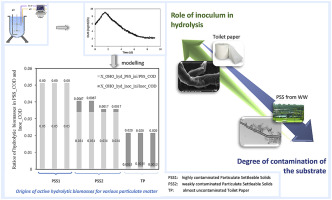当前位置:
X-MOL 学术
›
Water Res.
›
论文详情
Our official English website, www.x-mol.net, welcomes your feedback! (Note: you will need to create a separate account there.)
Hydrolysis of particulate settleable solids (PSS) in activated sludge is determined by the bacteria initially adsorbed in the sewage
Water Research ( IF 12.8 ) Pub Date : 2017-08-29 , DOI: 10.1016/j.watres.2017.08.058 Mourad Benneouala , Younès Bareha , Evrard Mengelle , Mansour Bounouba , Mathieu Sperandio , Yolaine Bessiere , Etienne Paul
Water Research ( IF 12.8 ) Pub Date : 2017-08-29 , DOI: 10.1016/j.watres.2017.08.058 Mourad Benneouala , Younès Bareha , Evrard Mengelle , Mansour Bounouba , Mathieu Sperandio , Yolaine Bessiere , Etienne Paul

|
Up to half of the organic fraction of an urban wastewater is made up of particulate settleable solids (PSS). In activated sludge process (AS) this material is rapidly adsorbed on to microbial flocs but is only slowly and partially degraded. To better understand and predict the degradation kinetics observed, a determination of the proportion of hydrolytic bacteria is required. As inoculum is usually added in the biodegradation tests, a comparison is required between the roles of bacteria introduced with the inoculum and those attached to the substrate. In this work, respirometric batch experiments were performed on PSS collected from upstream or downstream of the sewers of Toulouse city. Toilet paper (TP) and cellulose, two model particulate substrates, were also investigated. To understand the role of the active biomass in hydrolysis, increasing concentrations of AS were added to a certain amount of PSS or TP. No correlation was observed between the concentration of AS and the rate and duration of degradation of the particulate matter. Simulations performed after calibration of the model ASM-1 allowed the fraction of hydrolytic bacteria to be estimated in both the substrate and the AS-inoculum. Only a very small fraction of the bacteria of AS and of the substrate samples were found to be efficient for hydrolysis. Hydrolysis was mainly initiated by a small proportion of the microorganisms, and especially by cells already attached to PSSs. Moreover, the fraction of bacteria able to hydrolyse large particles present in an inoculum of AS depended on the initial contamination of the surface of the particles.
中文翻译:

活性污泥中颗粒状可沉降固体(PSS)的水解取决于最初吸附在污水中的细菌
城市废水中多达一半的有机物由可沉降颗粒物(PSS)组成。在活性污泥法(AS)中,该物质会迅速吸附到微生物絮凝物上,但只会缓慢而部分降解。为了更好地理解和预测观察到的降解动力学,需要确定水解细菌的比例。由于通常在生物降解试验中添加接种物,因此需要对随接种物引入的细菌的作用与附着在底物上的细菌的作用进行比较。在这项工作中,对从图卢兹市下水道的上游或下游收集的PSS进行了批量呼吸试验。卫生纸(TP)和纤维素,两种模型颗粒基质,也进行了研究。要了解活性生物质在水解中的作用,将增加浓度的AS添加到一定量的PSS或TP中。在AS的浓度与颗粒物降解的速率和持续时间之间未发现相关性。在对模型ASM-1进行校准后进行的仿真允许评估底物和AS菌落中水解细菌的比例。发现仅很小一部分的AS细菌和底物样品对水解有效。水解主要是由一小部分微生物引发的,尤其是由已经附着在PSS上的细胞引发。而且,能够水解存在于AS接种物中的大颗粒的细菌的比例取决于颗粒表面的初始污染。在AS的浓度与颗粒物降解的速率和持续时间之间未发现相关性。在对模型ASM-1进行校准后进行的仿真允许评估底物和AS菌落中水解细菌的比例。发现仅很小一部分的AS细菌和底物样品对水解有效。水解主要是由一小部分微生物引发的,尤其是由已经附着在PSS上的细胞引发。而且,能够水解存在于AS接种物中的大颗粒的细菌的比例取决于颗粒表面的初始污染。在AS的浓度与颗粒物降解的速率和持续时间之间未发现相关性。在对模型ASM-1进行校准后进行的仿真允许评估底物和AS菌落中水解细菌的比例。发现仅很小一部分的AS细菌和底物样品对水解有效。水解主要是由一小部分微生物引发的,尤其是由已经附着在PSS上的细胞引发。而且,能够水解存在于AS接种物中的大颗粒的细菌的比例取决于颗粒表面的初始污染。在对模型ASM-1进行校准后进行的仿真允许评估底物和AS菌落中水解细菌的比例。发现仅很小一部分的AS细菌和底物样品对水解有效。水解主要是由一小部分微生物引发的,尤其是由已经附着在PSS上的细胞引发。而且,能够水解存在于AS接种物中的大颗粒的细菌的比例取决于颗粒表面的初始污染。在对模型ASM-1进行校准后进行的仿真允许评估底物和AS菌落中水解细菌的比例。发现仅很小一部分的AS细菌和底物样品对水解有效。水解主要是由一小部分微生物引发的,尤其是由已经附着在PSS上的细胞引发。而且,能够水解存在于AS接种物中的大颗粒的细菌的比例取决于颗粒表面的初始污染。水解主要是由一小部分微生物引发的,尤其是由已经附着在PSS上的细胞引发。而且,能够水解存在于AS接种物中的大颗粒的细菌的比例取决于颗粒表面的初始污染。水解主要是由一小部分微生物引发的,尤其是由已经附着在PSS上的细胞引发。而且,能够水解存在于AS接种物中的大颗粒的细菌的比例取决于颗粒表面的初始污染。
更新日期:2017-08-30
中文翻译:

活性污泥中颗粒状可沉降固体(PSS)的水解取决于最初吸附在污水中的细菌
城市废水中多达一半的有机物由可沉降颗粒物(PSS)组成。在活性污泥法(AS)中,该物质会迅速吸附到微生物絮凝物上,但只会缓慢而部分降解。为了更好地理解和预测观察到的降解动力学,需要确定水解细菌的比例。由于通常在生物降解试验中添加接种物,因此需要对随接种物引入的细菌的作用与附着在底物上的细菌的作用进行比较。在这项工作中,对从图卢兹市下水道的上游或下游收集的PSS进行了批量呼吸试验。卫生纸(TP)和纤维素,两种模型颗粒基质,也进行了研究。要了解活性生物质在水解中的作用,将增加浓度的AS添加到一定量的PSS或TP中。在AS的浓度与颗粒物降解的速率和持续时间之间未发现相关性。在对模型ASM-1进行校准后进行的仿真允许评估底物和AS菌落中水解细菌的比例。发现仅很小一部分的AS细菌和底物样品对水解有效。水解主要是由一小部分微生物引发的,尤其是由已经附着在PSS上的细胞引发。而且,能够水解存在于AS接种物中的大颗粒的细菌的比例取决于颗粒表面的初始污染。在AS的浓度与颗粒物降解的速率和持续时间之间未发现相关性。在对模型ASM-1进行校准后进行的仿真允许评估底物和AS菌落中水解细菌的比例。发现仅很小一部分的AS细菌和底物样品对水解有效。水解主要是由一小部分微生物引发的,尤其是由已经附着在PSS上的细胞引发。而且,能够水解存在于AS接种物中的大颗粒的细菌的比例取决于颗粒表面的初始污染。在AS的浓度与颗粒物降解的速率和持续时间之间未发现相关性。在对模型ASM-1进行校准后进行的仿真允许评估底物和AS菌落中水解细菌的比例。发现仅很小一部分的AS细菌和底物样品对水解有效。水解主要是由一小部分微生物引发的,尤其是由已经附着在PSS上的细胞引发。而且,能够水解存在于AS接种物中的大颗粒的细菌的比例取决于颗粒表面的初始污染。在对模型ASM-1进行校准后进行的仿真允许评估底物和AS菌落中水解细菌的比例。发现仅很小一部分的AS细菌和底物样品对水解有效。水解主要是由一小部分微生物引发的,尤其是由已经附着在PSS上的细胞引发。而且,能够水解存在于AS接种物中的大颗粒的细菌的比例取决于颗粒表面的初始污染。在对模型ASM-1进行校准后进行的仿真允许评估底物和AS菌落中水解细菌的比例。发现仅很小一部分的AS细菌和底物样品对水解有效。水解主要是由一小部分微生物引发的,尤其是由已经附着在PSS上的细胞引发。而且,能够水解存在于AS接种物中的大颗粒的细菌的比例取决于颗粒表面的初始污染。水解主要是由一小部分微生物引发的,尤其是由已经附着在PSS上的细胞引发。而且,能够水解存在于AS接种物中的大颗粒的细菌的比例取决于颗粒表面的初始污染。水解主要是由一小部分微生物引发的,尤其是由已经附着在PSS上的细胞引发。而且,能够水解存在于AS接种物中的大颗粒的细菌的比例取决于颗粒表面的初始污染。



























 京公网安备 11010802027423号
京公网安备 11010802027423号